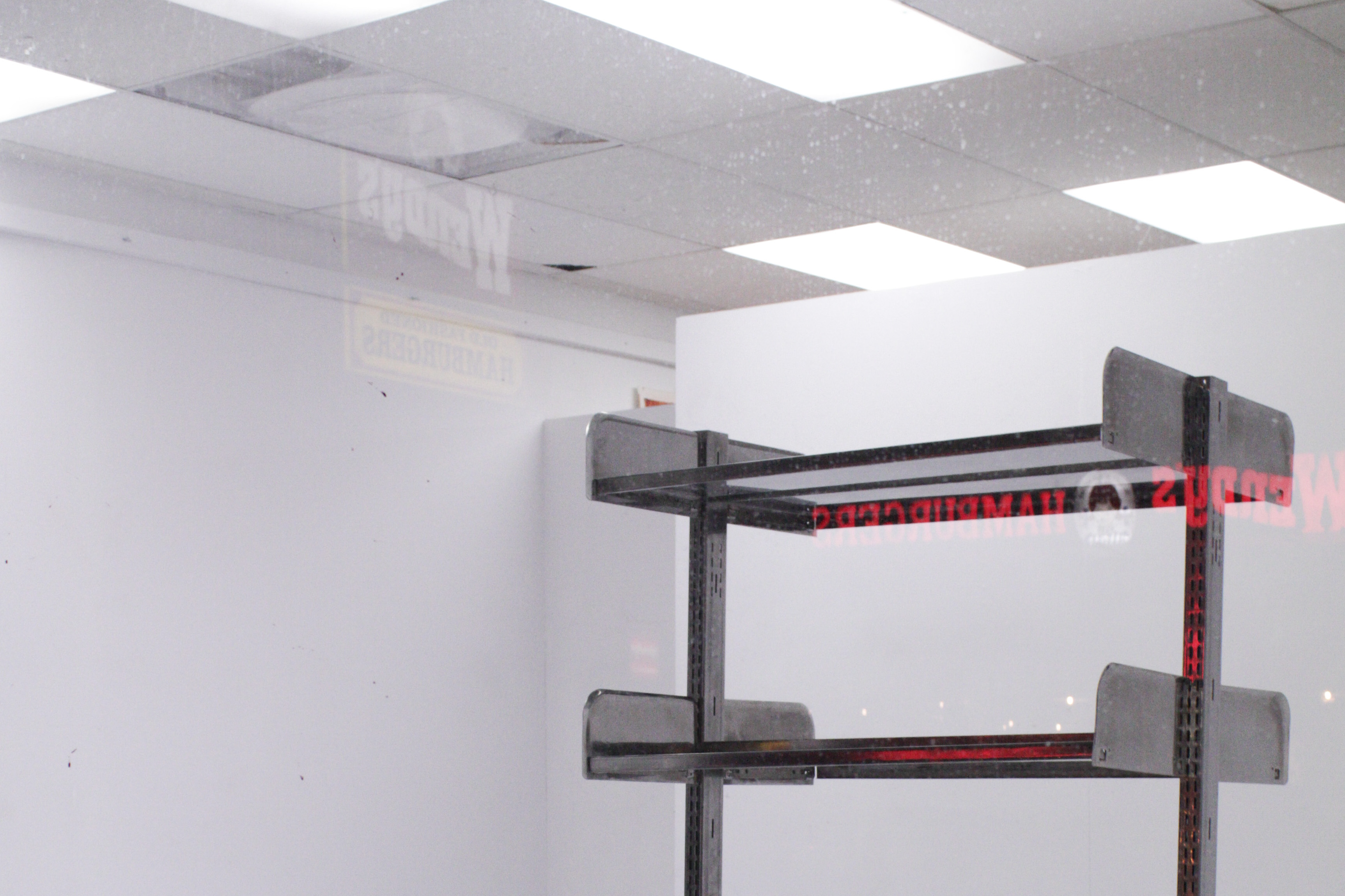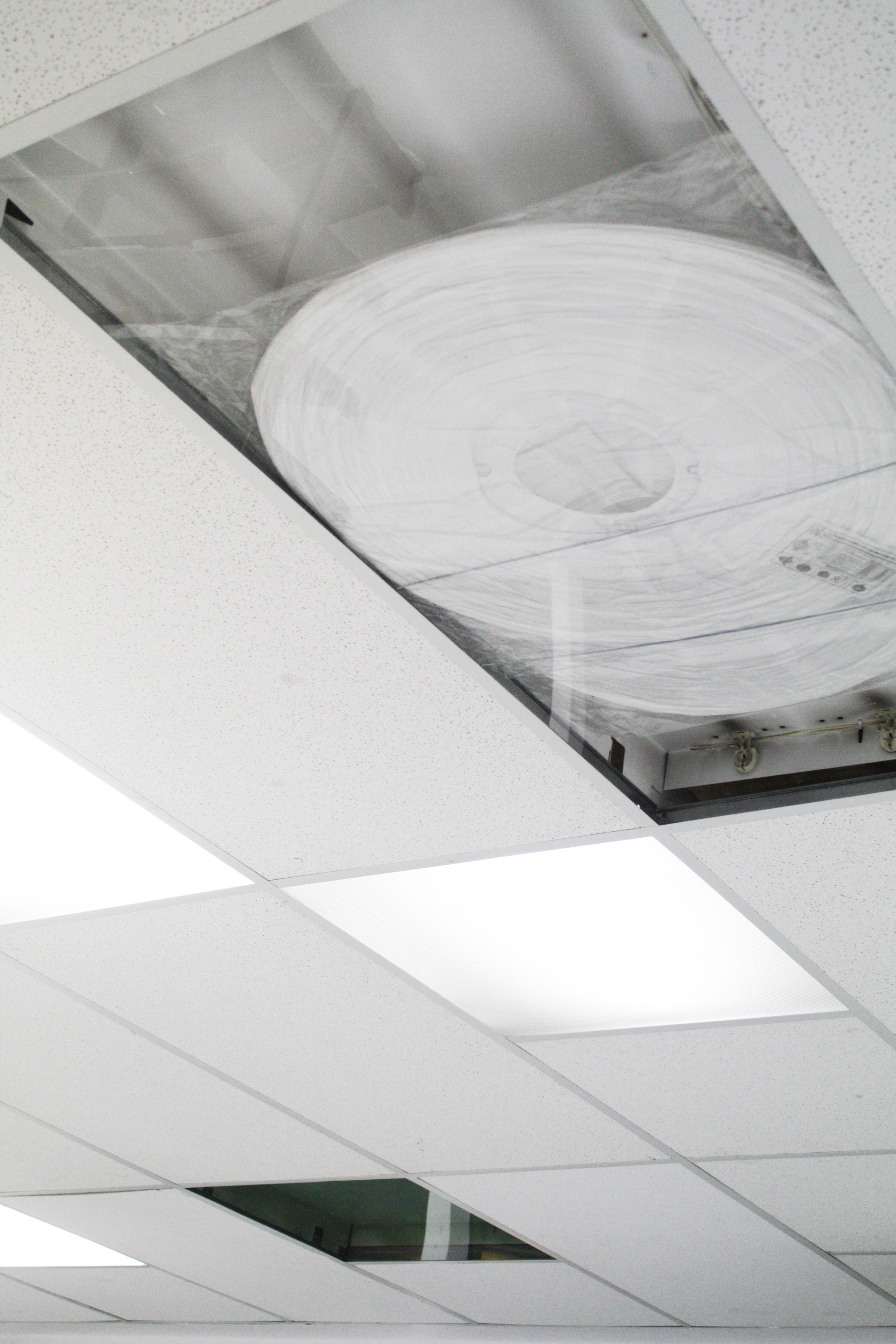
needs
Exhibition by Antje Tamae Barke
needs | Antje Tamae Barke | ODDLY, Tāmaki Makaurau
23.06.22 | written by Sascha Wall
Needs. Of necessity. Human needs, cultural needs, personal needs; the word holds a dominance that evokes a sense of unmatched importance within any given environment. Not a single sphere within our complex, intersectional society is exempt from pertaining to a set of needs that are essential for the survival, safety, autonomy and freedom of those within. Yet the significance of the word becomes so diluted through our western, capitalist lens that for many, it is almost synonymous with desires.
needs is a solo exhibition by Tāmaki Makaurau artist Antje Barke at ODDLY Project Space. Central to this body of work is a repurposed library shelving unit which commands the viewers’ foremost attention. As I enter the gallery space, I turn to look for more — and yet half-turned, I stay and instead stare back at my reflection in the shiny chrome of the shelves.
needs is a solo exhibition by Tāmaki Makaurau artist Antje Barke at ODDLY Project Space. Central to this body of work is a repurposed library shelving unit which commands the viewers’ foremost attention. As I enter the gallery space, I turn to look for more — and yet half-turned, I stay and instead stare back at my reflection in the shiny chrome of the shelves.
 Antje Tamae Barke, needs, 2022. Installation view. Includes ceiling interventions: Sage, 2022, acrylic spray paint on altered light box ceiling fixture; Double Bubble, 2022, ricepaper lanterns, plastic packaging, clear perspex fitted into flourescent light box ceiling fixture.
Antje Tamae Barke, needs, 2022. Installation view. Includes ceiling interventions: Sage, 2022, acrylic spray paint on altered light box ceiling fixture; Double Bubble, 2022, ricepaper lanterns, plastic packaging, clear perspex fitted into flourescent light box ceiling fixture. Before its closure in 2018, this very set of shelves sat in the Elam Fine Arts Library at the University of Auckland.1 The Elam library housed the biggest collection of art historical books and texts in the southern hemisphere. The idiosyncratic information required by artists varies greatly and the Elam library was a resource that rarely failed to meet the needs of those who engaged with it.2 In 2017, the University of Auckland reviewed the collections and operating costs of its Creative Arts Industry libraries, which included the Architecture & Planning, Music & Dance and Elam Fine Arts Libraries.3 Shortly after, offering little justification as to why, the decision was made to permanently close all three of the arts libraries.
Erasure is a slow violence. The quiet tragedy in closing academic libraries is the loss of information access, which goes against the very nature of the creative arts — to explore complex ideas and communicate them in new and unique ways. The Samoa House Library was a response to the closure, and is where a portion of the Elam collection now resides. However, this resolution was conceived and continues to be facilitated by artists and students and by no means corrects the systemic problem of under-resourcing in the arts.4
The shelves sit now, reflecting the poignant loss and sterilisation of knowledge, reappropriated in a near-empty gallery space without a single trace of the stories they were once home to. Spending hours sanding and stripping the shelves back to a shiny chrome, Barke elevates the shelves to the high status of aestheticism, simultaneously reducing them to a single, empty vessel — separated from both function and whakapapa. Barke imposes an irony at the intersection of value, labour, art, and capitalism.
I look up to the ceiling and notice that a light fixture has been removed and painted in a distinctive sage green. It feels looming and familiar. And now that I’m fixed on the ceiling, I see another cavity housing two plastic-packaged paper light shades folded flat on top of one another, sealed with perspex. Despite the sterile, severe nature of the install, I begin to sink into the work like a big old couch — feeling familiarity in all of the references within needs.
Erasure is a slow violence. The quiet tragedy in closing academic libraries is the loss of information access, which goes against the very nature of the creative arts — to explore complex ideas and communicate them in new and unique ways. The Samoa House Library was a response to the closure, and is where a portion of the Elam collection now resides. However, this resolution was conceived and continues to be facilitated by artists and students and by no means corrects the systemic problem of under-resourcing in the arts.4
The shelves sit now, reflecting the poignant loss and sterilisation of knowledge, reappropriated in a near-empty gallery space without a single trace of the stories they were once home to. Spending hours sanding and stripping the shelves back to a shiny chrome, Barke elevates the shelves to the high status of aestheticism, simultaneously reducing them to a single, empty vessel — separated from both function and whakapapa. Barke imposes an irony at the intersection of value, labour, art, and capitalism.
I look up to the ceiling and notice that a light fixture has been removed and painted in a distinctive sage green. It feels looming and familiar. And now that I’m fixed on the ceiling, I see another cavity housing two plastic-packaged paper light shades folded flat on top of one another, sealed with perspex. Despite the sterile, severe nature of the install, I begin to sink into the work like a big old couch — feeling familiarity in all of the references within needs.

Antje Tamae Barke, needs, 2022. Former Elam Library steel book shelf.
The title ‘needs,’ is borrowed from the retail store Everyday Needs, where Barke worked in 2021. Everyday Needs is an undeniably beautiful homewares store situated on Ponsonby Road. The shop is identifiable by its signature green, appearing on the exterior street sign. The high-end, high-quality products within Everyday Needs are sourced from around the country and the world, curated to utilitarian perfection on powder-coated, library-look shelves. The high price point dictates that many visitors are mere voyeurs, taking inventory of the things they aspire to own, mentally indulging in their luxury consumer fantasies.
Whilst Barke was working at Everyday Needs over the summer of 2021, an unfixed shelf of heavy stock fell from a height onto her head, causing a significant concussion. The incident was a catalyst for Barke in reflecting upon the moral conflict of her employment there. Much like many of the makers behind the products at Everyday Needs, Barke worked to afford rent, food and a studio space at Samoa House Library. In needs, Barke interrogates the irony and conflict of working in such a beautiful environment that aestheticises the lifestyles of her fellow creatives, for a price that is as out of reach to them as their lost resources.
At the final destination of this introspective hikoi, I am grounded in an uncomfortable space of inescapable self-reflection. Thinking of needs unfulfilled and needs falsely defined, I recognise my place in this narrative and lean into the familiar sense of loss and internal conflict. The closure of the Elam Fine Arts library was not an isolated incident — ripping the arts from its roots to make room for the expansion of faculties higher in capitalist priority. This has been happening for decades and will continue happening. The aesthetic lifestyle for sale under the guise of “needs” is equally ubiquitous. Though stripped right back to an empty steel waka, needs still carries the weight of lost resources, information, and whakapapa to the moorings of capitalist desire. Here, we are called to question our complicity in the continued devaluation of the arts and underappreciation of artists in Aotearoa.
Whilst Barke was working at Everyday Needs over the summer of 2021, an unfixed shelf of heavy stock fell from a height onto her head, causing a significant concussion. The incident was a catalyst for Barke in reflecting upon the moral conflict of her employment there. Much like many of the makers behind the products at Everyday Needs, Barke worked to afford rent, food and a studio space at Samoa House Library. In needs, Barke interrogates the irony and conflict of working in such a beautiful environment that aestheticises the lifestyles of her fellow creatives, for a price that is as out of reach to them as their lost resources.
At the final destination of this introspective hikoi, I am grounded in an uncomfortable space of inescapable self-reflection. Thinking of needs unfulfilled and needs falsely defined, I recognise my place in this narrative and lean into the familiar sense of loss and internal conflict. The closure of the Elam Fine Arts library was not an isolated incident — ripping the arts from its roots to make room for the expansion of faculties higher in capitalist priority. This has been happening for decades and will continue happening. The aesthetic lifestyle for sale under the guise of “needs” is equally ubiquitous. Though stripped right back to an empty steel waka, needs still carries the weight of lost resources, information, and whakapapa to the moorings of capitalist desire. Here, we are called to question our complicity in the continued devaluation of the arts and underappreciation of artists in Aotearoa.
 Antje Tamae Barke, needs, 2022. Detail.
Antje Tamae Barke, needs, 2022. Detail.Antje Tamae Barke, needs, 2022. 20 May – 04 June 2022 at ODDLY Project Space, Tāmaki Makaurau.
Photos: Antje Tamae Barke. Courtesy of the artist.

Article image: Antje Tamae Barke, needs, 2022. Installation view.
1. Exhibition Text, ‘Pure Negativity: for needs by Antje Barke’, OODLY, Daniel Corbett Sanders, 2022: https://www.oddlyprojects.com/purenegativity
2. ‘Why Closing the Arts Libraries at Auckland University is a Really Bad Idea’, The Spinoff, Reiley Hodson 2018: https://thespinoff.co.nz/auckland/14-04-2018/why-closing-the-art-libraries-at-auckland-university-is-a-really-big-deal
3. ‘CAI Libraries Review,’ The University of Auckland, Hester Mountifield, Kirsty Wilson, December 2017:
chrome-extension://efaidnbmnnnibpcajpcglclefindmkaj/https://savefineartslibrary.files.wordpress.com/2018/04/5-review-of-creative-arts-and-industries-cai-libraries3.pdf
4. Thanks to the hard work of the students and artists who opened the Samoa House Library in response to the closure, much of the Elam collection now resides there, though this is still off campus and less accessible than the on-site library.
See also:
‘A Library Is More Than Books: On The Proposed Closure of the Elam Fine Arts Library,’ Pantograph Punch, Rachel Ashby, 2018:
https://www.pantograph-punch.com/posts/more-than-books
Exhibition Text ‘Ex Libris: Samuel Harnett,’ Objectspace, Anna Miles and Lucy Treep, 2019:
https://www.objectspace.org.nz/exhibitions/ex-libris/#:~:text=The%20Elam%20School%20of%20Fine,record%20of%20the%20three%20libraries.
Photos: Antje Tamae Barke. Courtesy of the artist.
Article image: Antje Tamae Barke, needs, 2022. Installation view.
1. Exhibition Text, ‘Pure Negativity: for needs by Antje Barke’, OODLY, Daniel Corbett Sanders, 2022: https://www.oddlyprojects.com/purenegativity
2. ‘Why Closing the Arts Libraries at Auckland University is a Really Bad Idea’, The Spinoff, Reiley Hodson 2018: https://thespinoff.co.nz/auckland/14-04-2018/why-closing-the-art-libraries-at-auckland-university-is-a-really-big-deal
3. ‘CAI Libraries Review,’ The University of Auckland, Hester Mountifield, Kirsty Wilson, December 2017:
chrome-extension://efaidnbmnnnibpcajpcglclefindmkaj/https://savefineartslibrary.files.wordpress.com/2018/04/5-review-of-creative-arts-and-industries-cai-libraries3.pdf
4. Thanks to the hard work of the students and artists who opened the Samoa House Library in response to the closure, much of the Elam collection now resides there, though this is still off campus and less accessible than the on-site library.
See also:
‘A Library Is More Than Books: On The Proposed Closure of the Elam Fine Arts Library,’ Pantograph Punch, Rachel Ashby, 2018:
https://www.pantograph-punch.com/posts/more-than-books
Exhibition Text ‘Ex Libris: Samuel Harnett,’ Objectspace, Anna Miles and Lucy Treep, 2019:
https://www.objectspace.org.nz/exhibitions/ex-libris/#:~:text=The%20Elam%20School%20of%20Fine,record%20of%20the%20three%20libraries.
ISSN 2744-7952
Thank you for reading ︎
Vernacular logo designed by Yujin Shin
vernacular.criticism ︎

